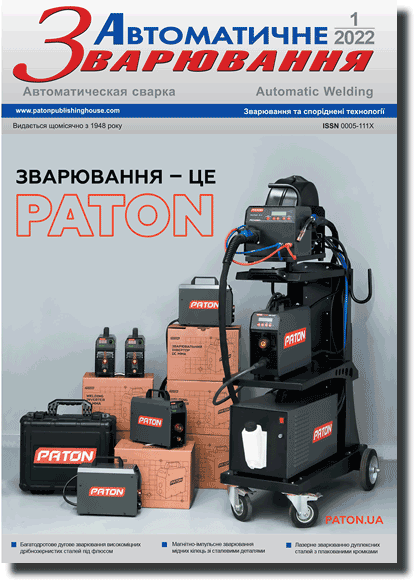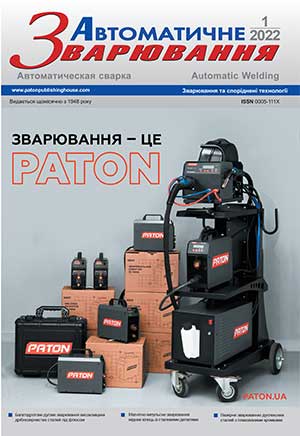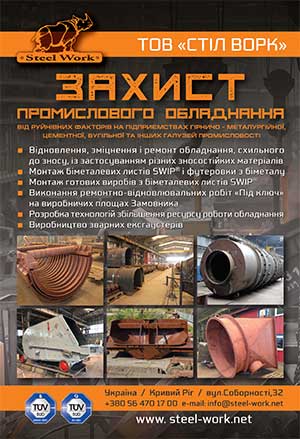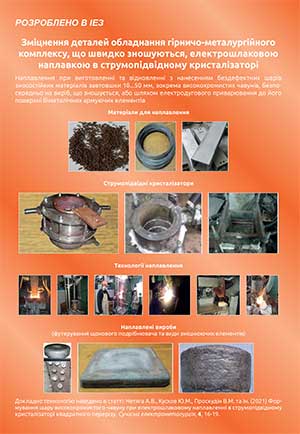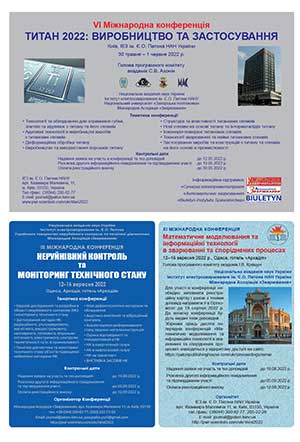| 2022 №01 (05) |
DOI of Article 10.37434/as2022.01.06 |
2022 №01 (07) |
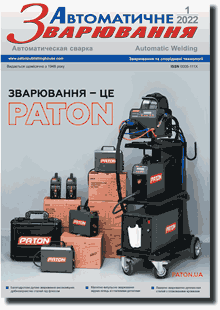
"Avtomatychne Zvaryuvannya" (Automatic Welding), #1, 2022, pp. 41-45
Formation of the penetration zone of the base metal in arc surfacing with the action of a longitudinal magnetic field
O.D. Razmyshlyaev1, M.V. Ahieieva2
1State Higher Educational Establishment «Pre-Azov State Technical University» (PSTU). 7, Universitetskaya Str., 87500, Mariupol, Ukraine. Е-mail: razmyshljaev@gmail.com
2Donbass State Machine Building Academy, 72, Akademicheskaya Str., 84313, Kramatorsk, Ukraine. Е-mail: maryna_ah@ukr.net
In the work, the assumption was experimentally confirmed that the longitudinal magnetic field (LMP) in submerged arc surfacing can have a braking effect on the speed of movement of liquid metal in the welding pool. Using the calculation method and physical modelling, the values of the braking force depending on the speed of movement of electric conductive bodies under the action of LMP were established. The performed experiments in arc surfacing using the submerged wire showed that at the action of both constant as well as alternating LMP of 50 Hz frequency, the thickness of the interlayer of liquid metal in the pool under the arc increases by approximately 1.5...2.0 times. This allows concluding that the fact of decrease in the penetration depth of the base metal during surfacing with the action of LMP is predetermined by the braking effect of the magnetic field on the speed of liquid metal flows in the pool, followed by increase in the thickness of the interlayer of liquid metal under the arc and deterioration of the efficiency of the arc heat transfer to the base metal. 10 Ref., 1 Tabl., 4 Fig.
Keywords: arc surfacing, longitudinal magnetic field, induction, flow braking, penetration depth
Received: 08.11.2021
References
1. Razmyshlyaev, A.D., Mironova, M.V. (2008) Peculiarities of base metal penetration in arc surfacing in longitudinal magnetic field. The Paton Welding J., 8, 18-22.2. Boldyrev, A.M., Birzhev, V.A., Chernykh, A.V. (1993) Control of penetration depth in arc welding and surfacing by longitudinal alternating magnetic field. Svarochn. Proizvodstvo, 6, 30-31 [in Russian].
3. Chang, Y.-l., Bai, J., Liu, D., Mei ,Q. (2016) Influence of longitudinal magnetic field on welding arc and formation of weld bead in CO2 welding. Journal of Shenyang University of Technology, 38, 6, 612-617.
4. Wang, L., Wu, C., Chen, J., Gao, J. (2018) Influence of the external magnetic field on fluid flow, temperature profile and humping bead in high speed gas metal arc welding. International Journal of Heat and Mass Transfer, 116, 1282-1291. https://doi.org/10.1016/j.ijheatmasstransfer.2017.09.130
5. Hua, A., Yin, S., Chen, S. et al. (2010) Behavior of arc and drop transfer of mag welding controlled by longitudinal magnetic field. Journal of Mechanical Engineering, 46, 14, 95-100. https://doi.org/10.3901/JME.2010.14.095
6. Yin, X., Gou, J., Ma, N. (2011) Numerical simulation of arc and weld pool for GTAW in external axial magnetic fields. Transactions of JWRI, Special Issue on WSE 2011, 17-27.
7. Mou, G., Hua, X., Wang, M. et al. (2020) Effect of axial magnetic field on cold metal transfer arc-brazing of Ti6Al4V to 304L steel. Journal of Materials Processing Technology, 275, 116322. https://doi.org/10.1016/j.jmatprotec.2019.116322
8. Yablonsky, A.A., Nikiforova, V.M. (2002) Course of theoretical mechanics. St.-Petersburg, Lan [in Russian].
9. Razmyshlyaev, A.D., Mironova, M.V., Deli, A.A. (2010) Speed of metal flows in the pool in arc surfacing in a longitudinal magnetic field. Welding International, 24, 8, 627-630. https://doi.org/10.1080/09507111003655531
10. Boldyrev, A.M., Birzhev, V.A., Chernykh, A.V. (1993) Calculation of hydrodynamic parameters of liquid metal at the bottom of the molten pool in arc welding. Ibid, 7(6), 481-483. https://doi.org/10.1080/09507119309548431
Advertising in this issue:
The cost of subscription/purchase order journals or individual articles
| Journal/Currency | Annual Set | 1 issue printed |
1 issue |
one article |
| TPWJ/USD | 384 $ | 32 $ | 26 $ | 13 $ |
| TPWJ/EUR | 348 € | 29 € | 24 € | 12 € |
| TPWJ/UAH | 7200 UAH | 600 UAH | 600 UAH | 280 UAH |
| AS/UAH | 1800 UAH | 300 UAH | 300 UAH | 150 UAH |
| AS/USD | 192 $ | 32 $ | 26 $ | 13 $ |
| AS/EUR | 180 € | 30 € | 25 € | 12 € |
| SEM/UAH | 1200 UAH | 300 UAH | 300 UAH | 150 UAH |
| SEM/USD | 128 $ | 32 $ | 26 $ | 13 $ |
| SEM/EUR | 120 € | 30 € | 25 € | 12 € |
| TDNK/UAH | 1200 UAH | 300 UAH | 300 UAH | 150 UAH |
| TDNK/USD | 128 $ | 32 $ | 26 $ | 13 $ |
| TDNK/EUR | 120 € | 30 € | 25 € | 15 € |
AS = «Automatic Welding» - 6 issues per year;
TPWJ = «PATON WELDING JOURNAL» - 12 issues per year;
SEM = «Electrometallurgy Today» - 4 issues per year;
TDNK = «Technical Diagnostics and Non-Destructive Testing» - 4 issues per year.





